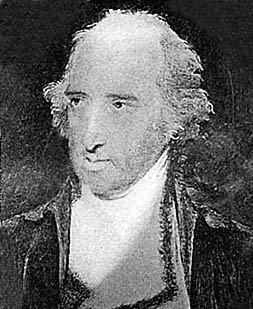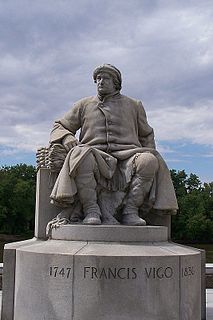Philippe DeJean (1736 – c.1809) was a judge in Fort Detroit until he was captured during the American Revolution.

Fort Pontchartrain du Détroit or Fort Detroit was a fort established on the west bank of the Detroit River by the French officer Antoine de la Mothe Cadillac in 1701. In the 18th century, French colonial settlements developed on both sides of the river, based on the fur trade, missions and farms.

The American Revolution was a colonial revolt that took place between 1765 and 1783. The American Patriots in the Thirteen Colonies won independence from Great Britain, becoming the United States of America. They defeated the British in the American Revolutionary War (1775–1783) in alliance with France and others.
He was born 5 April 1736 in Toulouse, France, the son of Philippe Dejean and Jeanne de Rocques de Carbouere. His father was a legal officer, and may have given his son legal training.
DeJean was living in North American by 1761, and was a merchant in Detroit by 1766. By that time, the Seven Years' War between Great Britain and France was over, and DeJean was under the jurisdiction of Great Britain. He was appointed Justice of the Peace in April 1767.

The Seven Years' War was a global conflict fought between 1756 and 1763. It involved every European great power of the time and spanned five continents, affecting Europe, the Americas, West Africa, India, and the Philippines. The conflict split Europe into two coalitions: one was led by the Kingdom of Great Britain and included the Kingdom of Prussia, the Kingdom of Portugal, the Electorate of Brunswick-Lüneburg, and other small German states; while the other was led by the Kingdom of France and included the Austrian-led Holy Roman Empire, the Russian Empire, the Kingdom of Spain, and the Swedish Empire. Meanwhile, in India, some regional polities within the increasingly fragmented Mughal Empire, with the support of the French, tried to crush a British attempt to conquer Bengal.
As the town surrounding Fort Detroit grew, DeJean's powers expanded, and he was soon appointed as Judge. The American Revolution created a crisis situation in which DeJean's authority as Judge and Henry Hamilton's authority as Lt-Governor went unchecked. Notably, in 1777 he executed Ann Wyley and a male accomplice for mere theft, in order to set an example to others. DeJean's reputation as a harsh judge who sometimes overstepped legal bounds was noticed beyond Detroit. Governor Guy Carleton criticized both DeJean and Hamilton for unjust and illegal acts, and they were both indicted in Montreal for "being tyrannical and acting illegally" [1]

Henry Hamilton was an Anglo-Irish military officer and later government official of the British Empire. He served in North America as Lieutenant Governor of the Province of Quebec and later as Deputy Governor after the Revolutionary War. He later served as Governor of Bermuda and lastly, as Governor of Dominica, where he died in office.
Ann Wyley was a slave hanged for burglary in Detroit, at the time part of the British Province of Quebec. She is the only black person and one of the only two women known to have been legally executed in Michigan, and the only woman whose identity is known.

Guy Carleton, 1st Baron Dorchester, KB, known between 1776 and 1786 as Sir Guy Carleton, was an Anglo-Irish soldier and administrator. He twice served as Governor of the Province of Quebec, from 1768 to 1778, concurrently serving as Governor General of British North America in that time, and again from 1785 to 1795. The title Baron Dorchester was created on 21 August 1786.
Hamilton left Detroit on an expedition to recapture Post Vincennes, South of Detroit along the Wabash River, which had recently declared its support for the Americans. DeJean, perhaps aware of his precarious legal position without the support of Hamilton, accompanied a convoy of reinforcements. Hamilton was captured at Fort Sackville by Colonel George Rogers Clark, and DeJean- along with some papers he neglected to destroy- was captured on the Wabash by Captain Leonard Helm.

Vincennes is a city in and the county seat of Knox County, Indiana, United States. It is located on the lower Wabash River in the southwestern part of the state, nearly halfway between Evansville and Terre Haute. Founded in 1732 by French fur traders, notably, François-Marie Bissot, Sieur de Vincennes for whom the Fort was named, Vincennes is the oldest continually-inhabited European settlement in Indiana and one of the oldest settlements west of the Appalachians.

The Wabash River is a 503-mile-long (810 km) river in Ohio and Indiana, United States, that flows from the headwaters near the middle of Ohio's western border northwest then southwest across northern Indiana turning south along the Illinois border where the southern portion forms the Indiana-Illinois border before flowing into the Ohio River. It is the largest northern tributary of the Ohio River. From the dam near Huntington, Indiana, to its terminus at the Ohio River, the Wabash flows freely for 411 miles (661 km). Its watershed drains most of Indiana. The Tippecanoe River, White River, Embarras River and Little Wabash River are major tributaries. The river's name comes from an Illini Indian word meaning "water over white stones".

George Rogers Clark was an American surveyor, soldier, and militia officer from Virginia who became the highest ranking American military officer on the northwestern frontier during the American Revolutionary War. He served as leader of the militia in Kentucky throughout much of the war. He is best known for his celebrated captures of Kaskaskia (1778) and Vincennes (1779) during the Illinois Campaign, which greatly weakened British influence in the Northwest Territory. The British ceded the entire Northwest Territory to the United States in the 1783 Treaty of Paris, and Clark has often been hailed as the "Conqueror of the Old Northwest".
DeJean was held as a prisoner in Williamsburg for four months, [2] after which time he was paroled because he was considered sympathetic to the American cause. [1] He returned to Vincennes, but did not return to Detroit for fear of prosecution for his abuses of power. His family, however, was not permitted to leave Detroit, and it appears that DeJean finally returned by late 1780.

Williamsburg is an independent city in the Commonwealth of Virginia, United States. As of the 2010 U.S. Census, the population was 14,068. In 2014, the population was estimated to be 14,691. Located on the Virginia Peninsula, Williamsburg is in the northern part of the Hampton Roads metropolitan area. It is bordered by James City County and York County.
Detroit court records from July 1790 indicate that he lived outside British dominions. Various records indicate that DeJean may have returned to France for a time, and/or may have relocated to Vincennes. An 1807 census of Vincennes lists Philip Dejean, Male over 21. The Dictionary of Canadian Biography lists his death in or after 1809, when documents cease to list his name.








